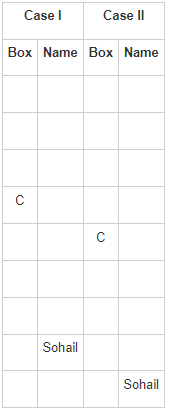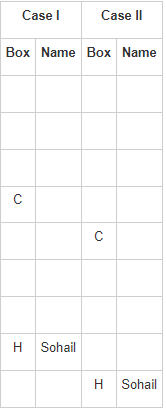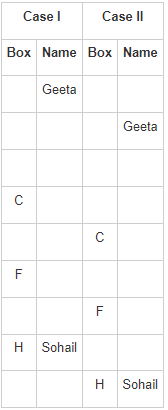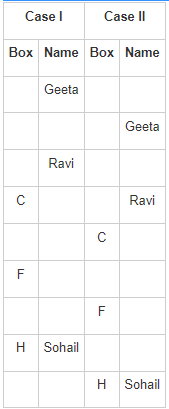Solutions
1) Box C is kept four boxes above the box that contains Sohail’s documents.
2) At least three boxes are kept above box C.
(As at least three boxes are kept above box C, implies, there are two possibilities here:
Case I: The box that contains Sohail’s files is kept at the second place from the bottom and accordingly, box C is kept at the fourth place from the top.
Case II: The box that contains Sohail’s file is kept at the bottom and accordingly, box C is kept at the fifth position from the top.)

3) Three boxes are kept between box H and box C.
4) Box H is not kept above box C.
(Implies, in both the cases, box H contains Sohail’s files.)

5) Only one box is kept between box F and box H.
(In both cases, box F would be above box H.
Case I: Box F would be in the fourth position from the bottom.
Case II: Box F would be in the third position from the bottom.)
6) Four boxes are kept between Geeta’s box and box F.
Case I: Geeta’s box is at the top.
Case II: Geeta's box is in the second position from the top.)

7) Only one box is kept between the boxes that contains Ravi’s and Geeta’s documents.
(As Geeta's box is either at the top or in the second position from the top, implies, Ravi's box must be below Geeta's box.
Case I: Ravi’s box must be in the third position from the top.
Case II: Ravi’s box must be in the fourth position from the top.)

8) At least six boxes are kept below the box that contains Ravi’s documents.
(Clearly, it is not possible in the second case as there are only five boxes below the box that contains Ravi’s documents. Hence, case II is not true and we will proceed with case I only.)
9) The box that contains Anu’s documents is kept above box C and below box B.
(Implies, the box that contains Anu’s documents is kept in the second position from the top as it is the only possibility. It further implies that box B contains Geeta’s document as it is the only box above Anu’s box.)

10) Box D is kept five boxes below the box that contains Mukesh’s documents.
(It is only possible if box C contains Mukesh’s documents and box D is kept at the bottom.)
11) Four boxes are kept between box E and box A.
(It is only possible if either box E or A contains Anu’s file and the other box is kept five boxes below it.)

12) Only one box is kept between the box that contains Sonam’s files and box A.
(If we assume that box A contains Anu's documents then there is no way we can place Sonam's box so that it satisfies the given condition. Hence, box E contains Anu's documents and box A is kept five boxes below it. Now, the box that contains Sonam’s files could either be above box A or below box A.)
13) Five boxes are kept between box I and the box that contains Richa’s documents.
(It is only possible if Richa's box is kept at the bottom and box I is kept at the third position from the top. Implies, box D contains Richa's files and box I contains Anu's file. It further implies that we cannot place Sonam's box below box A, hence, Sonam's box is kept two boxes above box A. Also, ow that only one box is left to be placed in the table i.e. box G, implies, box G is kept between box C and F as it is the only possibility.)

14) Box F does not contain Pawan’s documents.
(Implies, box A contains Pawan’s documents and box F contains Kapil’s documents.)

Clearly, box G contains Sonam’s file and it is placed in the fifth position from the top.



 Get latest Exam Updates
Get latest Exam Updates 





 ×
×






